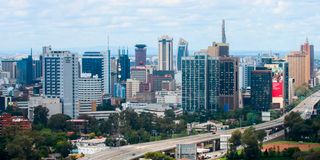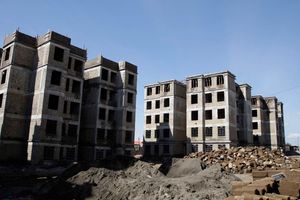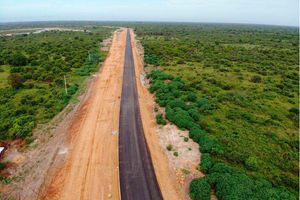
Nairobi City Skyline on April 27, 2023.
African cities are expanding at an unprecedented rate. By 2050, the continent’s urban population is expected to double, and by then one in every five humans on earth will be African with 65 per cent of them living in African cities.
Imagine for a minute what that means for our cities across the continent.
This rapid urbanization presents a monumental opportunity for growth and innovation, as we envision vibrant cities that can thrive amid this demographic shift.
What makes these statistics even more extraordinary is that the infrastructure needed to support this growth in 50 years has not yet been built. So, in fact leaders today should (and must) invest in planning our cities for the future, not the past.
That’s what made this week’s Green & Resilient UrbanShift Africa Forum 2025 so exciting.
Held in Nairobi, it convened over 250 African city leaders, policymakers, investors, and business leaders to address climate resilience and sustainable urban development. Hosted by C40 Cities and funded by the Global Environment Facility (GEF), the forum supported by UNEP, WRI, and ICLEI, provided a platform for exchanging best practices and fostering collaboration.
Discussions centred on resilience, urban planning, and infrastructure development, with a focus on securing climate financing for African cities.
It was a moment to reimagine African cities that will withstand the test of time and climate change, cities that are purposely built to serve the people who live in them, and are green, resilient, and sustainable. It was a call to action.
The urgency of this vision became painfully clear in March 2020, when the world came to a screeching halt.
The Covid-19 pandemic and the resultant sweeping lockdowns significantly altered our reality and our perception of our most important priorities.
As Nairobians we found solace in Uhuru Park, City Park, Karura, Oloolua and Ngong forests, and the scattered green spaces that still remained in the city. We learned to value these green havens not just as escapes but as precious spaces worth protecting.
They reminded us of nature’s power to heal and restore, even when everything else seemed so uncertain.
Why then despite all the information, experience and knowledge we have about the risks we face in our increasingly vulnerable cities, and the fantastic development and urban plans in place across our cities, are they not fully implemented? When I spoke at the forum this week, I argued that the bold UrbanShift we envision and that we must urgently deliver across our cities, is not hindered by a lack of leadership, investment, or even the tools and resources to combat climate impacts in these crazy times.
What our cities, and their leaders, truly need are shifts of a different kind — ones that transcend policies and funding, ones that strike at the very heart of our belief systems, and how we think, plan and act. At the Opening Plenary, I highlighted what I think are critical shifts holding the “UrbanShift” back. I addressed the mindset shift, policy shift, and finance shift that must be cultivated, and the necessary steps towards a sustainable urban future.
A mindset shift that cultivates a profound respect and reverence for nature; a policy shift that embeds sustainability into policy frameworks to create robust systems that withstand the test of time and climate challenges; and a finance shift that harmonizes green and gray solutions taking full advantage of new avenues of financing that would open up and we could build cities that are not only liveable but also resilient to climate impacts.
I left the UrbanShift 2025 forum both inspired and concerned. Inspired by initiatives like the Green-Gray Infrastructure Accelerator launched by WRI, the World Bank and the African Development Bank - an initiative to support 11 cities across sub-Saharan Africa to integrate green solutions with traditional “gray” infrastructure.
The initiative will provide technical, policy, and finance support, helping them lay the groundwork for their initial cohort of projects, while connecting others to financiers to scale existing efforts.
But I was also concerned about the enthusiasm and readiness of our city leaders to seize these opportunities.
Over 20 years ago, Karura Forest was a “no go zone” - today over 70,000 people visit monthly, including school children who come to learn from and love this forest.
The protection of the forest was thanks to a hard-fought policy shift led by the Green Belt Movement that ensured all titles that had been issued and illegally obtained were revoked.
This made way for the creation of Africa’s largest urban forest and the most visited recreation green space in the city of Nairobi.
But it is not lost to me that green spaces such as Karura, are constantly under threat today. What will it take to ensure these treasured and precious spaces continue to thrive and secure our lives in Nairobi?
It requires unwavering commitment from all stakeholders — government, communities, and individuals — to safeguard this vital ecosystem for future generations. Now is the time to demand the shifts we need.
Wanjira Mathai is the MD for Africa & Global Partnerships at the World Resources Institute and Chair of the Wangari Maathai Foundation.







